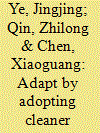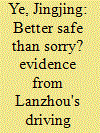|
|
|
Sort Order |
|
|
|
Items / Page
|
|
|
|
|
|
|
| Srl | Item |
| 1 |
ID:
182732


|
|
|
|
|
| Summary/Abstract |
We study how a low-emission zone (LEZ) policy affects air pollution in Nanchang, a medium-sized city located in southeastern China. By using a regression discontinuity design approach, we find that the LEZ policy improves Nanchang's air quality throughout restricted/unrestricted hours and within/outside of the designated LEZ areas. Air quality began to improve during the announcement period and improved further after the policy was enforced. These findings suggest that drivers could adapt to the foreseen LEZ policy by upgrading their vehicles; thus, to achieve policy effectiveness, it is important to make driving regulations compatible with drivers' incentives.
|
|
|
|
|
|
|
|
|
|
|
|
|
|
|
|
| 2 |
ID:
156449


|
|
|
|
|
| Summary/Abstract |
Driving restriction policies (DRPs) have been adopted worldwide to curb traffic congestion and air pollution. However, the empirical evidence of the effectiveness of such policies in improving air quality remains mixed (e.g., Davis, 2008; Viard & Fu, 2015). Individuals may change their commute schedules/routes or hire/purchase additional vehicles to circumvent such restrictions. This paper addresses this possibility by utilizing hourly measurements of air pollutants from monitoring stations at Lanzhou, one of the most polluted cities in China. Utilizing a regression discontinuity design (RD) approach, we concluded that the driving restrictions in Lanzhou are ineffective in improving its air quality. Specific hour and location results suggest that drivers shift their travel schedules, take detours, and acquire alternative vehicles. The results are robust after considering alternative model specifications and sample restrictions.
|
|
|
|
|
|
|
|
|
|
|
|
|
|
|
|
| 3 |
ID:
156461


|
|
|
|
|
| Summary/Abstract |
This paper aims to measure and understand the rural–urban student cognitive ability gap in China. Using the China Education Panel Survey (CEPS) 2013/2014 data, we find that the cognitive ability test scores of urban students are approximately 1.41 points (17%) higher than those of rural students, on average. This difference is equivalent to 37 and 41% of the standard deviation of urban and rural students' test scores, respectively. Instead of the raw test score, when the cognitive ability is estimated with the 3-parameter Logistic item response theory model, the rural–urban gap is somewhat reduced. The regression and Oaxaca–Blinder decomposition analyses show that nearly one-half of the rural–urban gap can be accounted for by differences in observed characteristics, especially number of siblings, parental education, and interaction between parents and teachers. We then discuss the policy implications of these results and propose a few potential ways to reduce the rural–urban gap in students' cognitive abilities.
|
|
|
|
|
|
|
|
|
|
|
|
|
|
|
|
|
|
|
|
|